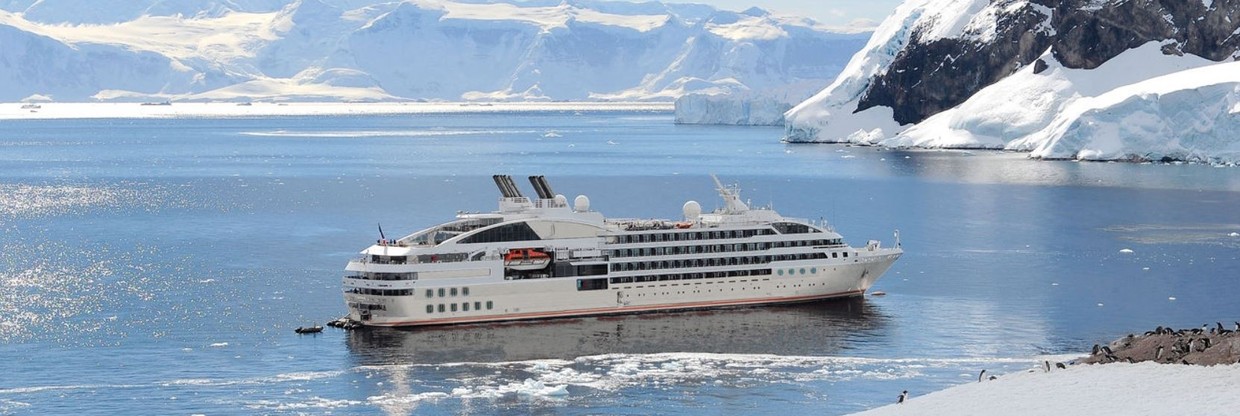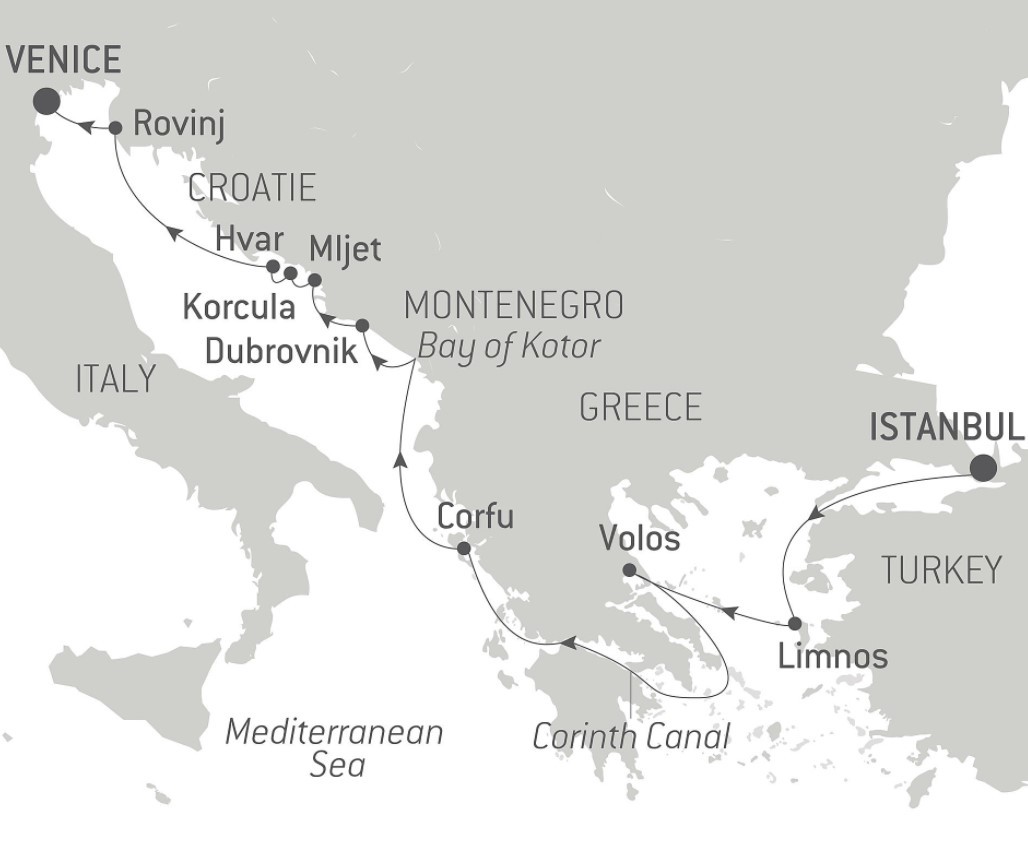2022-01-24
2025-01-01
Note: Current p/p indicative rate. Final price may change due to currency fluctuations.
Give in to the temptation of an exceptional cruise between the Bosphorus and the stunning Istanbul, and Venice and the shores of the Adriatic Sea. For ten days, sail the Mediterranean aboard Le Lyrial between Turkey, Greece, Montenegro, Croatia and Italy. Your cruise will begin in Istanbul, the gateway to the East between Europe and Asia, listed as World Heritage by UNESCO. You will discover the volcanic island of Limnos, near the Dardanelles Strait. Protected during Antiquity by Hephaestus, the god of fire, this green and lush island has now become one of Greece’s major seaside resorts. You will then head for the region of Thessaly, at the foot of Mount Pelion, in the port of Volos. Among the treasures of this region, you will be able to discover the Meteora, a magnificent set of sandstone rock formations listed with UNESCO, atop which monasteries were built. On board Le Lyrial, you will take the astonishing Corinth Canal, a famous sea channel dug out by men in the 19th century. Next Corfu, the most famous Ionian island, will reveal the hidden treasures of its Greco-Byzantine and Venetian architectural heritage. Do not miss the chance to visit the Achilleion, the luxurious neoclassical palace built for the Empress Sissi. Your ship will chart a course north towards Montenegro where the Bay of Kotor, a UNESCO World Heritage Site will welcome you for a wonderful journey through four mountainous gulfs where sheer cliffs plunge into a deep blue sea. You will then head to the aptly named “Pearl of the Adriatic”, Dubrovnik, a UNESCO World Heritage site. Surrounded by medieval ramparts, its terracotta-tiled roofs, its palaces, cloisters and fountains are bound to impress you and will plunge you into the heart of Croatian history. Then the national park of the island of Mljet, surrounded by a wildly beautiful coastline, will be the occasion for a timeless interlude in the shade of the green oaks and Aleppo pines, between lush vegetation and saltwater lakes. You will also be able to discover the mountain island of Korčula and its medieval city, where Marco Polo was born. After a stop on the magnificent island of Hvar, the last stage of your trip will take you to Rovinj, giving you an opportunity to discover this city with Venetian influences. Moreover, it proudly bears Venice’s symbolic winged lion on the Balbi's Arch, which you’ll be able to admire during a stroll through its picturesque town centre. As a grand finale, your voyage will draw to an end in Venice the Serenissima and its lagoon.
Located on the Bosphorus, Istanbul is one of the most beautiful of all Turkish cities. Named Byzantium when founded by the Greeks, and then Constantinople under the Roman Empire, this city is steeped in history and, for this reason, is a listed UNESCO World Heritage site. Located on Sultanahmet hill, the great Blue Mosque, the mysterious Hagia Sophia and the vast Topkapi palace and its countless mosaics, dominate the Marmara Sea. In the Beyazit district, the Grand Bazaar allows to discover elegant covered passages. A little further away, delicate aroma of loukoum and spices will draw the visitors’ attention at the Egyptian Bazaar.
A volcanic island located near the Dardanelles Strait, Limnos was venerated during Antiquity. Legend has it that Hephaestus, the god of fire, had his forge here. Now one of Greece’s major seaside resorts, Lemnos offers its visitors many superb sandy beaches. It is also home to several archaeological sites, such as the towers of Kastro, an ancient acropolis fortified by the Venetians, or the neolithic site of Poliochni and the city of Hephaestia. Renowned for its olives, fruits, wheat and honey, and for the authenticity of its inhabitants, Lemnos is also known for the quality of its restaurants, ideal for tasting typical Greek dishes.
Volos, one of the biggest port cities in Greece, is located at the foot of Mount Pelion. According to mythology, Mount Pelion was a place of celebration for gods and heroes, and the home of the centaurs. The beauty of the place and the magical atmosphere that reigns here can indeed only have been inspired by the gods: the clear water that flows from a multitude of sources bathes the plane trees, apple trees, oaks, beech trees, gardenias, camellias, and hydrangeas that thrive in the fertile soil of Thessaly. Do not miss your chance to visit picturesque village of Milies in the hills, and to discover its traditional architecture.
The Corinth Canal cuts through the Isthmus of Corinth, turning the Peloponnese into an island as it separates the region from the Greek mainland. Inaugurated in 1893, the canal is a little over six kilometres long and enables merchant vessels and passenger to avoid a long 400-km detour around the peninsula. The two sides of the canal reach a height of approximately fifty metres. From the exterior decks, don’t miss this unique opportunity to watch the ship as it navigates along the narrow strip of water encased between tall, ochre cliffs. What an experience!
Named after the island, Corfu is the most famous city in the Ionian islands. Protected by citadel fortifications, its old city, designated UNESCO World Heritage, displays unusual Greco-Byzantine and Venetian architecture. Above the water stands Saint George’s church, looking uncannily like a classical temple. The picturesque Pontikonisi, a stone’s throw from the southern point of the town, is the legendary island where Odysseus landed.
The long walls of the fortified city of Kotor unfurl before your eyes as you admire this medieval construction enclosed between the sea and the rugged cliffs from the decks of your ship. The still, deep waters of the bay plus the clouds of mist floating here and there create a surreal and magical atmosphere. Small islands with churches and fortresses built on them remind us that a proud maritime people has lived here for centuries, in this bay that forms a perfect natural harbour, used by sailors since ancient times. At the crossroads of Latin and Byzantine cultures, you will have the pleasure of observing the natural treasures of Montenegro during an unforgettable journey. Emblem of the Dalmatian coast, Dubrovnik is magnificently positioned on a rocky spur. History is sovereign here, in this ancient city, now a listed UNESCO World Heritage site. You will perhaps be surprised by the proportions of La Placa, the central drag through the city. The sheer width of it can be explained by the fact that it straddles a former lagoon. The elegant houses along La Placa are built in the legendary travertine stone. At Pile gate, you will be greeted by the statue of the patron saint of Dubrovnik, and you can admire the coastline as you walk along the ramparts. But what’s inside Fort Saint John, adjoining the outer walls? A maritime museum and an aquarium featuring rare fish from the Adriatic.
Discover Mljet Island off the Pelješac peninsula. Known for its national park and its protected forests, this Croatian splendid, pristine island offers many opportunities for walking with bays linked to two salt water lakes. On the largest lake, Veliko Jezero, a small island is home to an old Benedictine monastery. This harbour town has a very special location, presiding on a spur on the north-eastern coast of the island of Korçula. The ramparts in its medieval district provide perfect vantage points over the Pelješac peninsula. To get there, you can take the monumental staircase in the Revelin Tower. Another way is to climb the steps in the shade of palm trees from the MorskaVrata (Marine portal). As you make your way through the little streets, you’ll see the bell-tower of Saint Mark’s cathedral rise above you. This landmark will help you locate the house where Marco Polo was born. The island also has some of its own famous wines like the red Plavac and the white Posip.
Off the coast of Split, Hvar will surprise you by its traditions that have not changed since Antiquity. The country’s oldest town, Stari Grad, is here on this Dalmatian Island. The town nestles by a cove on the north-west coast, surrounded by dry stone wall structures on the Stari Grad plains. These have been designated a UNESCO World Heritage site because they were built in the time of the Ancient Greeks. From these parcels of land come wines and olive oil manufactured manually. In the upper part of town, it is possible to discover hams and cheeses made by local producers.
Rovinj is located in Istria, a region bordering Slovenia. This becomes apparent as you walk through its old cobblestoned town. There are many monuments of Venetian influence here. If you study the Balbi arch, you will see the winged lion, symbol of Venice. The bell-tower erected beside Saint Euphemia Cathedral was designed like the bell of Saint Mark in Venice. From the top of the tower, you can scan the entire historical district. To absorb its quaint atmosphere, take a walk in the ochre and sepia-coloured streets leading to bustling squares and terraces shaded by canvas awnings.
Proud and eternal, Venice has reigned on its lagoon ever since the 6th century. You may think you know this city before even setting foot here. You will inevitably fall in love with the charm of the innumerable treasures of the Serenissima: Saint Mark’s square, the basilica, Doges palace, the Grand Canal and the gondolas. Yet, secret Venice is also waiting for you to explore its little interlacing streets and canals, to ramble through its squares and to push open the doors of its churches. The city’s extraordinary heritage shouldn’t stop you from enjoying a glass of Spritz and a few tramezzini.
Itineraries are subject to change.

Vessel Type: Luxury Small Ship Length: 142 metres Passenger Capacity: 224 Launched: 2015 A sleek silhouette, a welcoming intimate atmosphere, discover aboard this new ship the philosophy that has made our sisterships such a success: the spirit of Yacht Cruises. Sailing under the French flag, this magnificent yacht of only 122 staterooms and Suites, with balconies, will join our fleet in April 2015. You will be enchanted by the contemporary decor inspired by the our destinations and the blue light of the Vega star in the Lyra constellation. The result is a subtle variation around a palette of blues, ranging from the luminous delicate grey-blue of the Polar ice to splashes of the vivid turquoise blue found in Mediterranean coves A refined ambiance is enhanced by the quality of the workmanship and materials: white Corian counters in the lobby contrast with the warmth of leather to recall a boat’s hull, while the central sculpture of enamelled pieces takes its inspiration from the sea. In the loungebar, the carpet picks up a tennis stripe theme symbolising a certain idea of cruising, one synonymous with French elegance and a chic seaside spirit.
• A Mediterranean cruise combining breathtaking scenery and exceptional cultural visits as you discover five countries: Turkey, Greece, Croatia, Montenegro and Italy. • UNESCO World Heritage Sites: the Meteora from Volos, ), the old towns of Corfu and Dubrovnik, Bay of Kotor, the plain of Stari Grad on the island of Hvar. • Crossing the Corinth Canal. • Sailing in the Bay of Kotor. • Panorama of the Croatian islands: Hvar and Rovinj.
